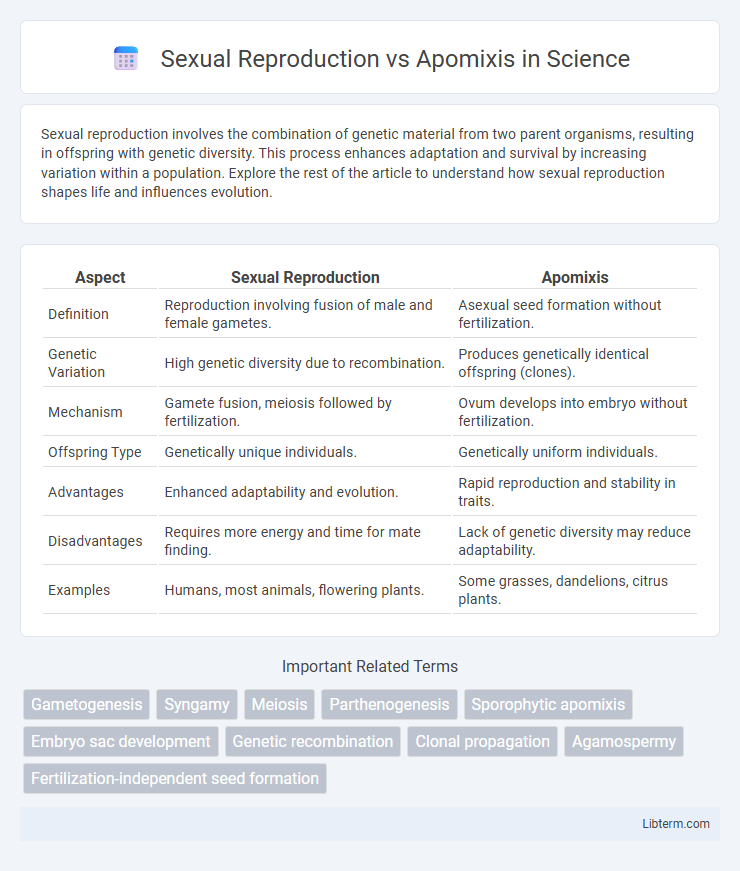Sexual reproduction involves the combination of genetic material from two parent organisms, resulting in offspring with genetic diversity. This process enhances adaptation and survival by increasing variation within a population. Explore the rest of the article to understand how sexual reproduction shapes life and influences evolution.
Table of Comparison
| Aspect | Sexual Reproduction | Apomixis |
|---|---|---|
| Definition | Reproduction involving fusion of male and female gametes. | Asexual seed formation without fertilization. |
| Genetic Variation | High genetic diversity due to recombination. | Produces genetically identical offspring (clones). |
| Mechanism | Gamete fusion, meiosis followed by fertilization. | Ovum develops into embryo without fertilization. |
| Offspring Type | Genetically unique individuals. | Genetically uniform individuals. |
| Advantages | Enhanced adaptability and evolution. | Rapid reproduction and stability in traits. |
| Disadvantages | Requires more energy and time for mate finding. | Lack of genetic diversity may reduce adaptability. |
| Examples | Humans, most animals, flowering plants. | Some grasses, dandelions, citrus plants. |
Introduction to Sexual Reproduction and Apomixis
Sexual reproduction involves the fusion of male and female gametes, resulting in genetic variation through meiosis and fertilization, which enhances adaptability and evolution in plants and animals. Apomixis is an asexual reproduction mechanism where seeds develop without fertilization, producing offspring genetically identical to the parent, common in certain plant species like dandelions and citrus. This contrast highlights that sexual reproduction promotes diversity, while apomixis ensures clonal propagation for stability in favorable environments.
Key Definitions: Sexual Reproduction vs Apomixis
Sexual reproduction involves the fusion of male and female gametes resulting in genetic variation among offspring. Apomixis is a form of asexual reproduction where seeds develop without fertilization, producing genetically identical clones of the parent plant. These distinct reproductive strategies impact plant breeding, biodiversity, and crop improvement efforts.
Mechanisms of Sexual Reproduction
Sexual reproduction involves the fusion of haploid gametes through meiosis, creating genetically diverse offspring by recombining parental chromosomes. This process includes stages such as gametogenesis, fertilization, and zygote development, essential for genetic variation and adaptation. In contrast, apomixis bypasses meiosis and fertilization, producing clonal seeds without genetic recombination.
Mechanisms of Apomixis
Apomixis is an asexual reproductive mechanism in plants where seeds develop without fertilization, bypassing the typical meiotic processes seen in sexual reproduction. It involves processes like diplospory, where the embryo sac forms from an unreduced megaspore, and apospory, where somatic cells of the ovule give rise to the embryo sac. This mechanism ensures clonal propagation, preserving genetic uniformity across generations and offering advantages in agriculture for maintaining desirable traits.
Genetic Variation: Differences and Similarities
Sexual reproduction generates genetic variation through the combination of parental alleles during meiosis and fertilization, resulting in offspring with unique genetic profiles. In contrast, apomixis produces genetically identical progeny by bypassing meiosis and fertilization, maintaining clonal uniformity. Both processes influence plant evolution and adaptation, but sexual reproduction enhances genetic diversity while apomixis preserves genetic stability.
Evolutionary Significance of Each Method
Sexual reproduction generates genetic diversity through the recombination of parental genes, enhancing adaptability and evolutionary potential in changing environments. Apomixis produces offspring genetically identical to the parent, preserving advantageous traits and enabling rapid colonization in stable habitats. The evolutionary significance of sexual reproduction lies in its role in promoting variation, while apomixis ensures trait stability and consistency across generations.
Advantages of Sexual Reproduction
Sexual reproduction promotes genetic diversity by combining genetic material from two parents, enhancing adaptability and survival in changing environments. This increased variation helps populations resist diseases and environmental stresses more effectively than apomixis, which produces genetically identical offspring. Furthermore, sexual reproduction facilitates evolution by enabling beneficial mutations to spread through populations over generations.
Advantages of Apomixis
Apomixis enables plants to reproduce asexually through seeds, preserving the genetic identity of superior genotypes without genetic variation, which ensures uniformity and stability in crop traits. This process eliminates the need for pollination and fertilization, allowing reproduction in environments with scarce pollinators or unfavorable mating conditions. Apomixis accelerates breeding programs by fixing hybrid vigor across generations, reducing costs and time involved in producing consistent high-yielding cultivars.
Agricultural and Ecological Implications
Sexual reproduction in plants generates genetic diversity crucial for crop resilience against pests, diseases, and environmental stressors, enhancing long-term agricultural sustainability. In contrast, apomixis allows for the clonal propagation of superior genotypes, ensuring uniformity and stable yield across generations without the need for repeated hybridization. Ecologically, sexual reproduction supports ecosystem adaptability through genetic variation, while apomixis can lead to reduced genetic diversity, potentially increasing vulnerability to changing environmental conditions.
Future Prospects and Applications
Sexual reproduction drives genetic diversity through meiosis and fertilization, enabling adaptability in changing environments and crop improvement via hybrid vigor. Apomixis offers promising applications by producing clonal seeds identical to the parent plant, ensuring trait stability and rapid propagation of elite genotypes. Future prospects include integrating apomixis genes into major crops to revolutionize agriculture, reduce breeding cycles, and enhance food security through uniform, high-yield varieties.
Sexual Reproduction Infographic

 libterm.com
libterm.com